Urban wildfires disrupt streams and their tiny inhabitants − losing these insects is a warning of bi
After wildfires in California and Colorado cities, levels of harmful metals in the water jumped. Nature sent up a red flag.
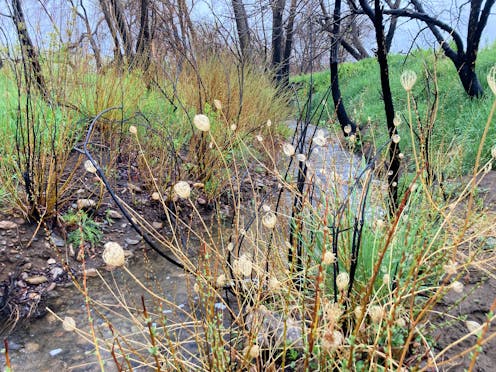
A tiny, vibrant world thrives along the rocky bottom of most streams. As sunlight filters through the water, mayfly nymphs, no larger than your fingernail, cling to algae-coated cobbles. Their brushlike mouthparts scrape the greenish coating, leaving faint trails as they feed. Six spindly legs anchor them against the current, while feathery gills wave gently, drawing oxygen from the flowing water.
This scene is common in well-maintained creeks and streams that flow through populated areas. But when wildfires sweep through, the toxic materials left behind can devastate this ecosystem.
When you think of urban wildfires, you might picture charred trees and houses. But beneath the surface of nearby streams, fires can also cause a silent upheaval – one that affects populations of creatures that are important indicators of the water’s health.
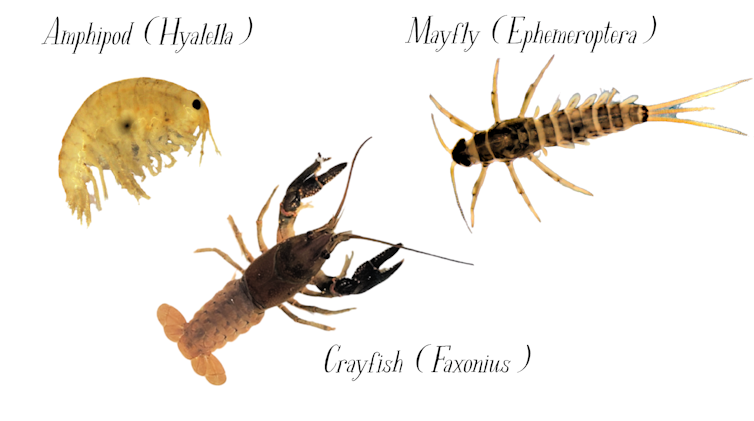
Wildfires are a natural part of many ecosystems. They rejuvenate landscapes by clearing out dead brush and releasing nutrients from vegetation and soils.
When fires move from nature into neighborhoods, however, they encounter a drastically different set of fuels. Urban conflagrations consume a mix of synthetic and natural materials, including homes, vehicles, electronics and household chemicals. This creates a unique set of problems that can have far-reaching consequences for waterways and the creatures that call them home.
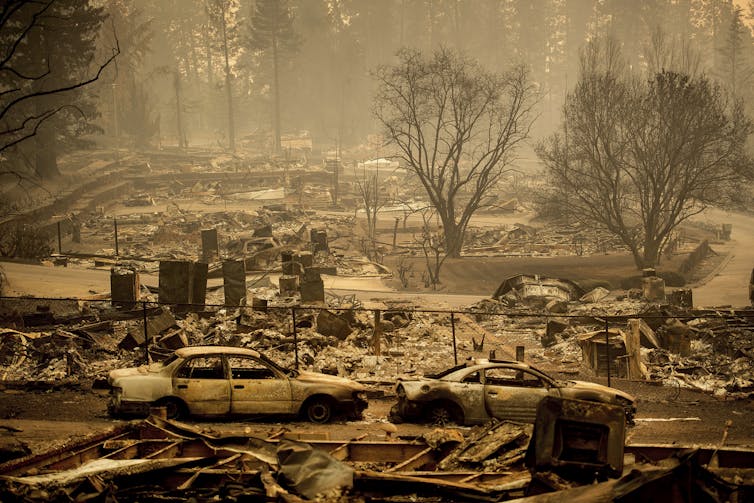
As an environmental engineer, I study how human actions on land affect the chemistry and ecology of surface water systems, including an important group of stream dwellers: benthic macroinvertebrates. These tiny creatures, which include mayflies, stone flies and caddis flies, are not only food sources for fish and other stream life but also serve as nature’s own water quality monitors.
2018’s Camp Fire was a wake-up call
In November 2018, the Camp Fire devastated the town of Paradise, California, destroying over 18,000 homes and other structures. In the aftermath of this tragic event, my colleagues and I examined the effects of large-scale urban burning on the chemistry of nearby watersheds.
The results were alarming: Metal concentrations in affected watersheds increased dramatically – up to two-hundredfold compared with prefire levels. Concentrations of these metals exceeded EPA aquatic habitat acute criteria, recommended levels that indicate when a metal has reached the threshold of “toxic” for organisms in the water.
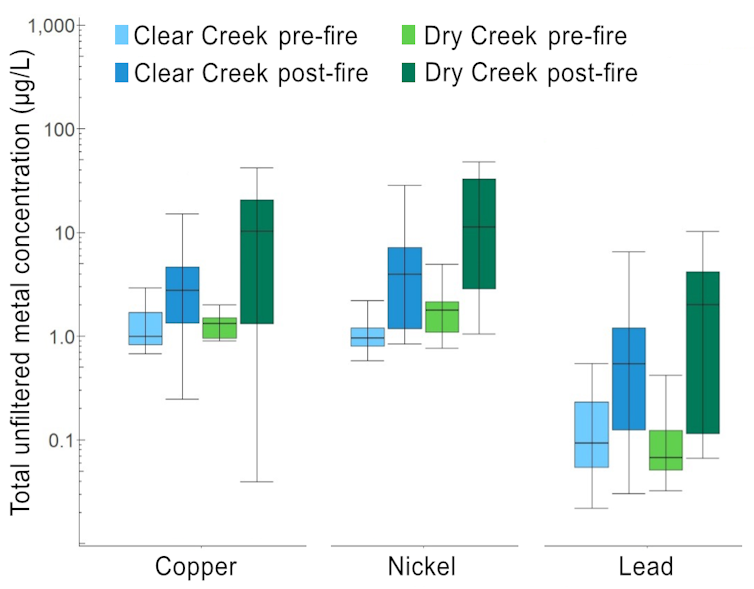
These elevated metal levels can pose risks to both ecosystems and human health.
For humans, contaminated watersheds can compromise drinking water sources by requiring extensive water treatment or even making some water supplies temporarily unusable.
Wildlife, particularly sensitive aquatic species such as fish and amphibians, face immediate threats from these pollutants. The toxic metals can disrupt their reproductive cycles, impair growth and destabilize ecosystems. Tiny benthic macroinvertebrates provide early warnings of the harm.
Silent witnesses: Benthic macroinvertebrates
In their larval stages, benthic macroinvertebrates live on the benthos, or bottom, of the stream, where they are constantly exposed to the water, making them sensitive to changes in stream chemistry.
Fly-fishing enthusiasts might recognize these creatures as the inspiration for the flies they tie. They are food for other aquatic life, but their presence, diversity and abundance also provide insight into both short-term pollution events and long-term environmental changes that chemical tests alone might miss.

Many species have short life cycles, allowing scientists to observe changes quickly. Different species also have varying tolerances for pollution, providing a nuanced picture of water quality.
Marshall Fire dramatically altered water quality
Just as we were finishing up our analysis of the Camp Fire samples, on Dec. 30, 2021, the Marshall Fire devastated communities in my home state of Colorado, destroying over 1,000 homes in Boulder County’s Coal Creek watershed.
For two years following the fire, I worked with a team at the University of Colorado Boulder to monitor water chemistry, benthic macroinvertebrate populations and algae in Coal Creek. We found that the runoff from fire debris dramatically altered both water quality and the ecological balance at fire-affected sites.
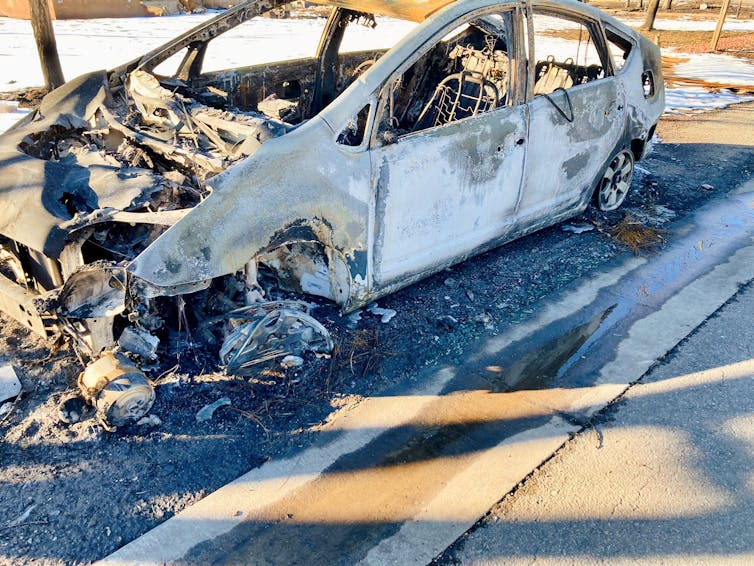
Our findings showed persistently elevated toxic metal levels and declines in sensitive aquatic species, indicating potential long-term risks to human activities, such as fishing and irrigation. They also showed that recovery would likely take many years.
Urban wildfires create a toxic cocktail for streams
Similar to after the Camp Fire, at Boulder County’s urban, fire-affected sites, we observed elevated concentrations of nutrients and metals, including copper, nickel, lead and zinc. By measuring stormwater, we were able to show that these pollutants were conveyed by concrete drainage systems that quickly funneled the water into the creek. We noted 84 instances where metal concentrations exceeded EPA aquatic life criteria limits in the first year.
We also measured significant changes in the types and numbers of benthic macroinvertebrates present. One of the most striking findings was the impact on algae-eating mayflies, which are particularly sensitive to changes in water quality.
In the burned urban stretch of the stream, we observed an interesting phenomenon: abundant algae growth, but fewer algae-eating mayflies. This suggests that fire runoff is having a dual effect on the stream ecosystem: Nutrients from burned vegetation are likely stimulating algae growth, while toxic metals from the urban fire debris seem to be negatively affecting sensitive organisms such as mayflies.
The algae, while plentiful, may be accumulating toxic metals from the water. When other organisms consume this algae, they could potentially ingest these metals as well. This process, known as bioaccumulation, can lead to increasing concentrations of toxic materials moving up the food chain.
What does the evidence mean?
It’s important to note that the full impacts of urban wildfires on stream life are still being studied. We can’t yet say definitively whether organism numbers are low because those organisms are dying or if they are experiencing subtler effects, such as reduced reproduction. The decrease in mayfly populations, however, is a concerning indicator of ecosystem stress.
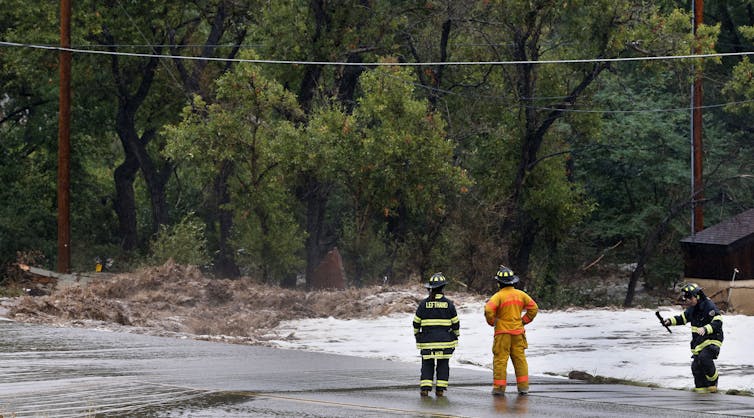
For humans, the implications are nuanced. While Coal Creek isn’t a source of drinking water, it is used for irrigation and recreation. Metal-contaminated water could accumulate in stream sediments and continue to affect sensitive organisms long term.
The creek’s overall health also affects its ability to filter water and support biodiversity.
Protecting streams and their ecosystems
The story told by these streams and their tiny inhabitants is clear: Urban wildfires pose a serious threat to water quality and aquatic life. To protect streams, communities need to reduce fire risk and runoff afterward. Improving urban planning, management of stormwater and watershed monitoring can help safeguard water resources.
The health of streams affects the health of communities. Everyone can benefit by listening to the mayflies’ warning.
Lauren Magliozzi has received funding from the National Science Foundation (NSF), the Colorado Water Conservation Board (CWCB), and the City of Boulder Open Space and Mountain Parks (OSMP).
Read These Next
From truce in the trenches to cocktails at the consulate: How Christmas diplomacy seeks to exploit s
World leaders like to talk up peace at Christmastime. But alongside the tales of seasonal breaks in…
How to reduce gift-giving stress with your kids – a child psychologist’s tips for making magic and a
Depending on family circumstances and a child’s personality type, gift giving runs the gamut of fun…
Medieval peasants probably enjoyed their holiday festivities more than you do
The Middle Ages weren’t as dreary and desperate as you’d think, and peasants often had weeks of…





